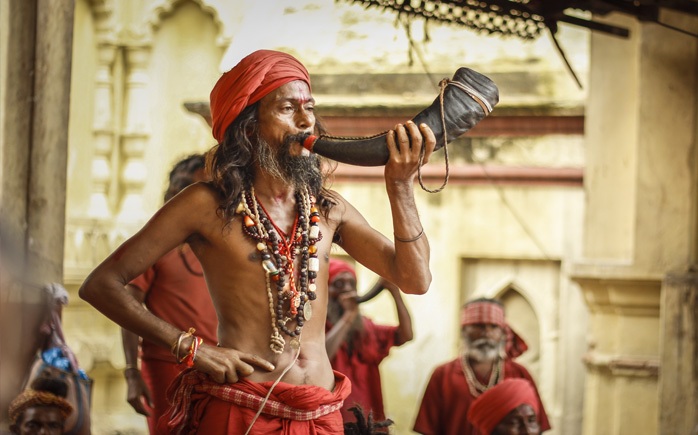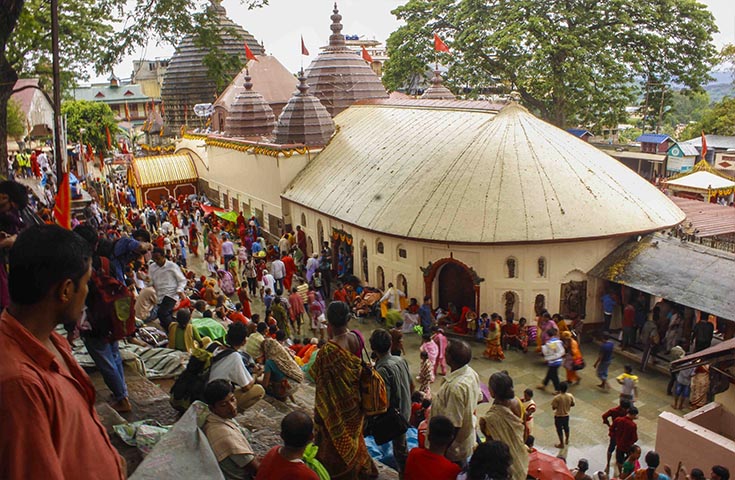On top of the Nilachal Hills in the western part of Guwahati lays the sacred and the most visited sight in Assam, the Kamakhya Temple. Every year in mid-June for four consecutive days, the revered Kamakhya Devi temple witnesses a large congregation of tantrik cult sadhus, and the devotees alike at her premises during the Ambubachi Mela.
It is the celebration of the annual menstruation cycle of the temple’s presiding deity ‘Devi Kamakhya’. She is Mother Earth, the ‘goddess of desire’ the one who grants salvation and her temple is one of the fifty-one Shaktipeeths spread over the sub-continent. It is believed that during the time of the fair, the productive and nourishing menses of the mother Earth is accessible to devotees at the temple. This fascinating belief makes this fair so special and millions of devotees from all over the country and abroad camp in and around the temple making Ambubachi Mela – The Kumbh of Northeast India.
Maa Kamakhya is a form of Devi Mahamaya or Durga. It is said that the Devi used to evince here in many forms (Rupa) – as a virgin and also as a spouse of Lord Shiva. In amorous mood in her ‘Sambhoga Rupa’ she is Goddess Kama, thus the name Kamakhya derived for satisfying her love for Lord Shiva. According to the holy books, it is also the place where her Yoni (Vulva) fell after Lord Shiva danced Tandava with her corpse. Perhaps this is the only reason why there is no idol inside the main temple hall and it is just a cracked stone in a shape of a Vulva with a natural spring coming out of it.
Kamakhya temple signifies fertility, sex & procreation, thus this ancient Shaktipeetha has high significance among the Tantrik & Shakti cult devotees. Due to such close connection with the tantra, mantra, and Siddhi, this festival is also known as Tantrik Fertility Festival and there are many tantriks who make a public appearance only in these four days.
The temple door remains closed for the first three days and it reopens on the fourth day for the devotees to get the blessing of the goddess soon after she regains her purity. On first three days, the sadhus meditate, perform yogic feats, and sing holy songs to attain transcendental consciousness.
Local Beliefs and Practices during the Ambubachi Mela
- All the temples in Assam are closed during the Ambubachi Mela and it is forbidden to perform daily worship or any religious activities.
- The farmers don’t go to the field on these days and it is forbidden to plow the earth.
- Widows can have only fruits during the first three days.
- It is forbidden to pluck fruits and flowers from the trees.
- On the fourth day, all the houses are cleaned up properly and the clothes, bed sheet etc that were used in the earlier three days is washed or sent for laundry.
History and Legend of Kamakhya Temple
According to the archaeological evidence the Kamakhya Temple is believed to be constructed between 8th to 9th century by the rulers of Mlechchha dynasty. But it was at the time of the Pala rulers of Kamrupa when it became an important seat of Tantrikism.
In her long existence, it was destroyed and rebuilt many times during the medieval age. The present-day structure is the result of the all the reconstruction efforts made by the Koch dynasty and the Ahom dynasty at the time of their rule.
It is said that the Koch Bihar royal family is cursed by the Devi herself and they are not allowed to enter inside the temple. Till this date, no descendant from the Koch dynasty visits the temple to worship or even stare upwards towards the Nilachal hill while passing by.
Late Maharani Gayatri Devi of Jaipur who also belongs to the royal family of Koch Bihar had to travel to Guwahati, she was informed that the one can see Kamakhya temple while the aircraft land on the airport. She immediately changed her flight route from Kolkata to Silchar and preferred to travel by road to Guwahati.
How to reach
To visit Kamakhya Temple one will have to reach Guwahati city. The nearest railway station is the Kamakhya and the railway station and the Guwahati airport located at a distance of just 19 km only. Direct city buses are also available from the major city points like Pan Bazaar, Paltan Bazaar, & Khanapara.
The taxi services are also available from the city or a shared taxi can be hired from the foothill of the Nilachal Hill at a minimum fare but during Ambubachi Mela neither private vehicles nor public vehicles are allowed to commute. Taking the age-old stone cut staircase from ‘Mekhelaujua’ will be the wisest decision at this time.
Ambubachi Mela fill colors to the Guwahati city, the streets are all lit-up and the markets remain busy all through day and night. Even for an atheist, visiting the Kamakhya temple during Ambubachi Mela will be an amazing experience. The folk musicians who come from West Bengal enthrall everyone with their lively rendition of Baul songs. It is a hypnotic trance that will control the state of mind for quite a long time. Mela also draws lots of photographers and videographers because of all the colorful events that take place in these four days. The Sadhus and sannyasinis in their saffron, black, blue or red attires and yogis performing hilarious yoga asanas reveal some of the wonderful sights to capture.
Become a part of Ambubachi Mela, the largest religious fair or the Kumbh of India’s Northeast to understand the fascinating practices of the Tantrik cult of Hinduism. Come here to see how these ancient beliefs still bind everyone to firmly believe in its existence even in the 21st century.





